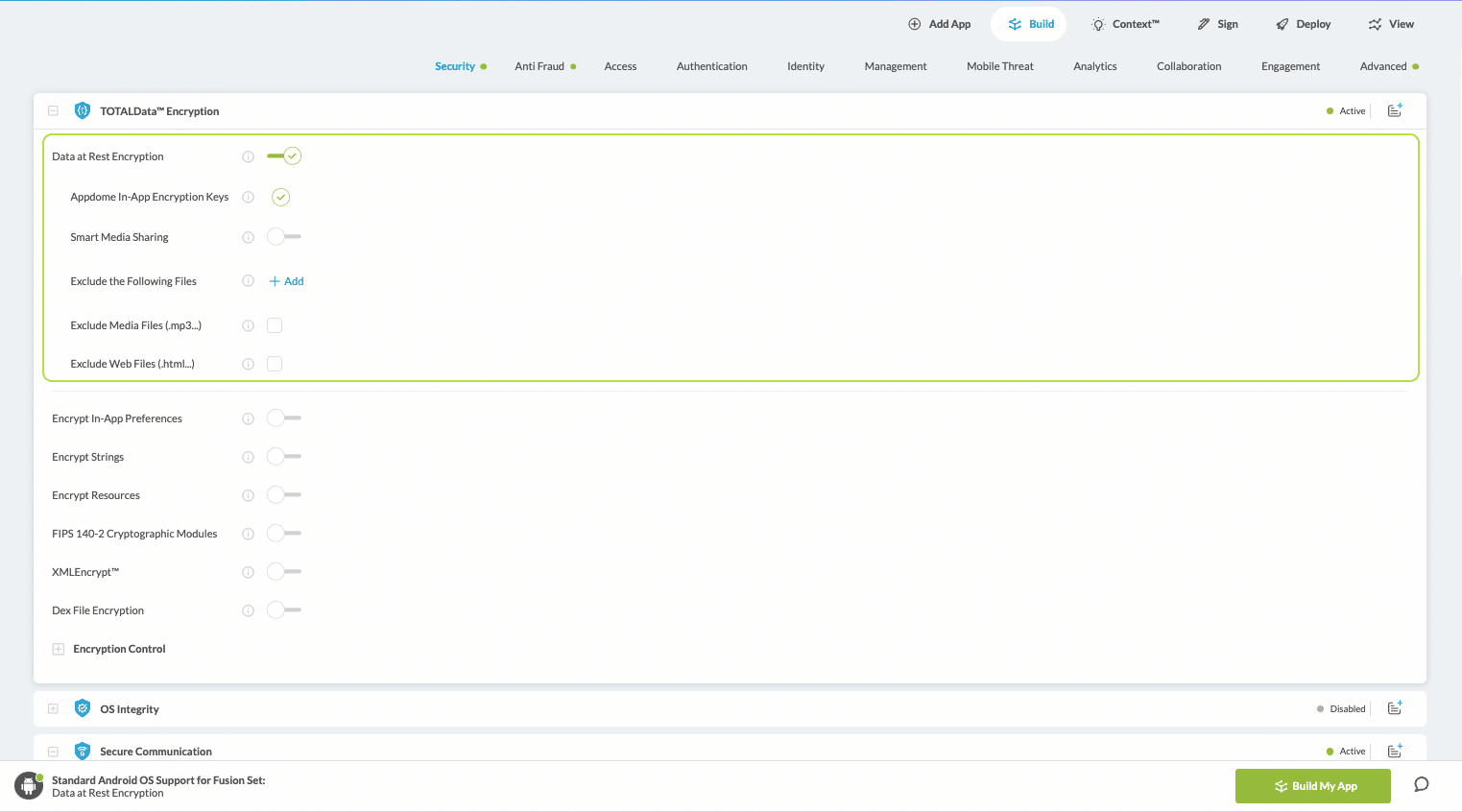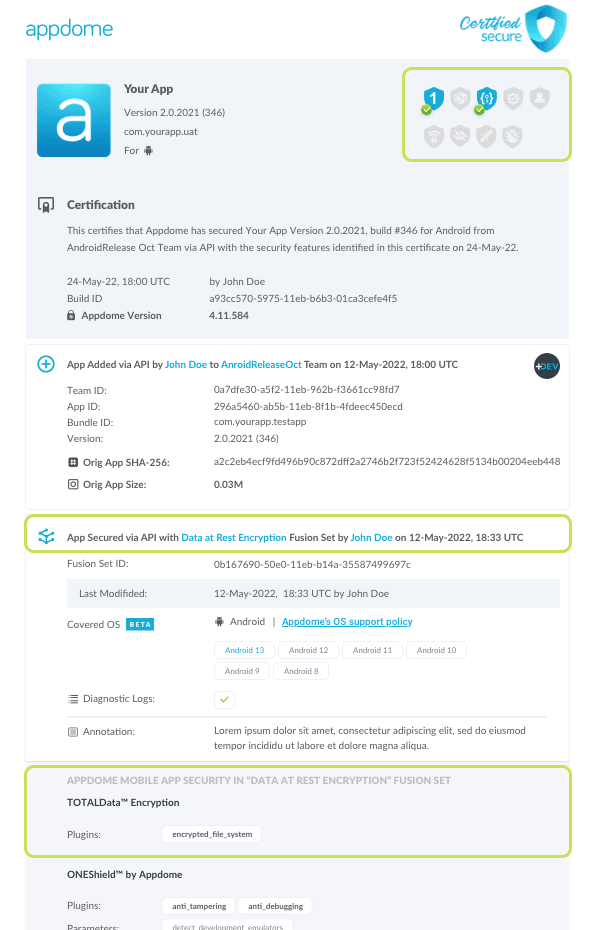How to Encrypt Data at Rest in Android or iOS Apps
Learn to Prevent Data Breach in Mobile apps, in mobile CI/CD with a Data-Driven DevSecOps™ build system.
What is Data at Rest?
Data at Rest is data that has reached a destination and is not being accessed or used. Due to its nature, Data at Rest is of increasing concern to businesses, government agencies and other institutions, which recognize the potential for data breach. These organizations realize that not only database management systems and file servers but also mobile devices need to have this data protected; the longer data is left unused in storage, the more likely it might be retrieved by unauthorized individuals outside the network.
How does Appdome Protect Data at Rest?
Using Appdome Data at Rest encryption, all data generated by the app is encrypted at runtime using industry-standard AES 256 cryptographic protocols. You can also choose to encrypt data in use/in memory, where all data temporarily stored in application memory is encrypted before it is sent/saved. With Appdome, encryption is accomplished dynamically, without any dependencies on the data structure, databases or file structures.
Note:
While the certificate image displayed below belongs to an Android app, the instructions and data in this article refer to both iOS and Android.
Prerequisites for Using Data at Rest Encryption:
To use Appdome’s mobile app security build system to Prevent Data Breach , you’ll need:
- Appdome account (create a free Appdome account here)
- A license for Data at Rest Encryption
- Mobile App (.ipa for iOS, or .apk or .aab for Android)
- Signing Credentials (see Signing Secure Android apps and Signing Secure iOS apps)
Prevent Data Breach on Mobile apps using Appdome
On Appdome, follow these 3 simple steps to create self-defending Mobile Apps that Prevent Data Breach without an SDK or gateway:
-
Upload the Mobile App to Appdome.
-
Upload an app to Appdome’s Mobile App Security Build System
-
Upload Method: Appdome Console or DEV-API
-
Mobile App Formats: .ipa for iOS, or .apk or .aab for Android
-
Data at Rest Encryption Compatible With: Obj-C, C+, Java, JS, C#, C++, Swift, Kotlin, Flutter, React Native, Unity, Xamarin, and more
-
-
Build the feature: Data at Rest Encryption.
-
Building Data at Rest Encryption by using Appdome’s DEV-API:
-
Create and name the Fusion Set (security template) that will contain the Data at Rest Encryption feature as shown below:
-
Follow the steps in Sections 2.2.1-2.2.2 of this article, Building the Data at Rest Encryption feature via Appdome Console, to add the Data at Rest Encryption feature to this Fusion Set.
-
Open the Fusion Set Detail Summary by clicking the “...” symbol on the far-right corner of the Fusion Set, as shown in Figure 1 above, and get the Fusion Set ID from the Fusion Set Detail Summary (as shown below):

Figure 2: Fusion Set Detail Summary
Note: Annotating the Fusion Set to identify the protection(s) selected is optional only (not mandatory). -
Follow the instructions below to use the Fusion Set ID inside any standard mobile DevOps or CI/CD toolkit like Bitrise, App Center, Jenkins, Travis, Team City, Cirlce CI or other system:
-
Build an API for the app – for instructions, see the tasks under Appdome API Reference Guide
-
Look for sample APIs in Appdome’s GitHub Repository
-

Figure 1: Fusion Set that will contain the Data at Rest Encryption feature
Note: Naming the Fusion Set to correspond to the protection(s) selected is for illustration purposes only (not required). -
-
Building the Data at Rest Encryption feature via Appdome Console
To build the Data at Rest Encryption protection by using Appdome Console, follow the instructions below.
-
Where: Inside the Appdome Console, go to Build > Security Tab > TOTALData™ Encryption section.
-
When you select the Data at Rest Encryption you'll notice that your Fusion Set you created in step 2.1.1 now bears the icon of the protection category that contains Data at Rest Encryption

Figure 4: Fusion Set that displays the newly added Data at Rest Encryption protection
- Extra Configuration with Data at Rest Encryption:
- Smart Media Sharing
Apply secured Media files and content handoff to external and embedded media players. Secured handoff is done on-demand, and on-the-fly.
- Exclude the Following Files
Exclude list of files and directories. You can add specific file names, sets of filenames with wildcard characters and directories separated by commas (e.g. log.txt, *.jpg, tmp/*).
- Exclude Media Files (.mp3...)
When turned ON, media files can be shared to leverage external media apps and browsers.
- Exclude Web Files (.html...)
When turned ON, local web file caching is enabled and will not be encrypted for web-intense apps.
-
Click Build My App at the bottom of the Build Workflow (shown in Figure 3).
-
Congratulations! The Data at Rest Encryption protection is now added to the mobile app -
Using Appdome, there are no development or coding prerequisites to build secured Mobile Apps by using Data at Rest Encryption. There is no SDK and no library to code or implement in the app and no gateway to deploy in your network. All protections are built into each app and the resulting app is self-defending and self-protecting.
Releasing and Publishing Mobile Apps with Data at Rest Encryption
After successfully securing your app by using Appdome, there are several available options to complete your project, depending on your app lifecycle or workflow. These include:
- Customizing, Configuring & Branding Secure Mobile Apps
- Deploying/Publishing Secure mobile apps to Public or Private app stores
- Releasing Secured Android & iOS Apps built on Appdome.
Related Articles:
- How to Apply Data-at-Rest Encryption to downloads performed via Android’s DownloadManager API
- How to Provide Secure Offline Data Access for iOS & Android
- How to Encrypt Assets & Resources in Android Apps
If you have any questions, please send them our way at support.appdome.com or via the chat window on the Appdome platform.
Thank you!
Thanks for visiting Appdome! Our mission is to secure every app on the planet by making mobile app security easy. We hope we’re living up to the mission with your project.


